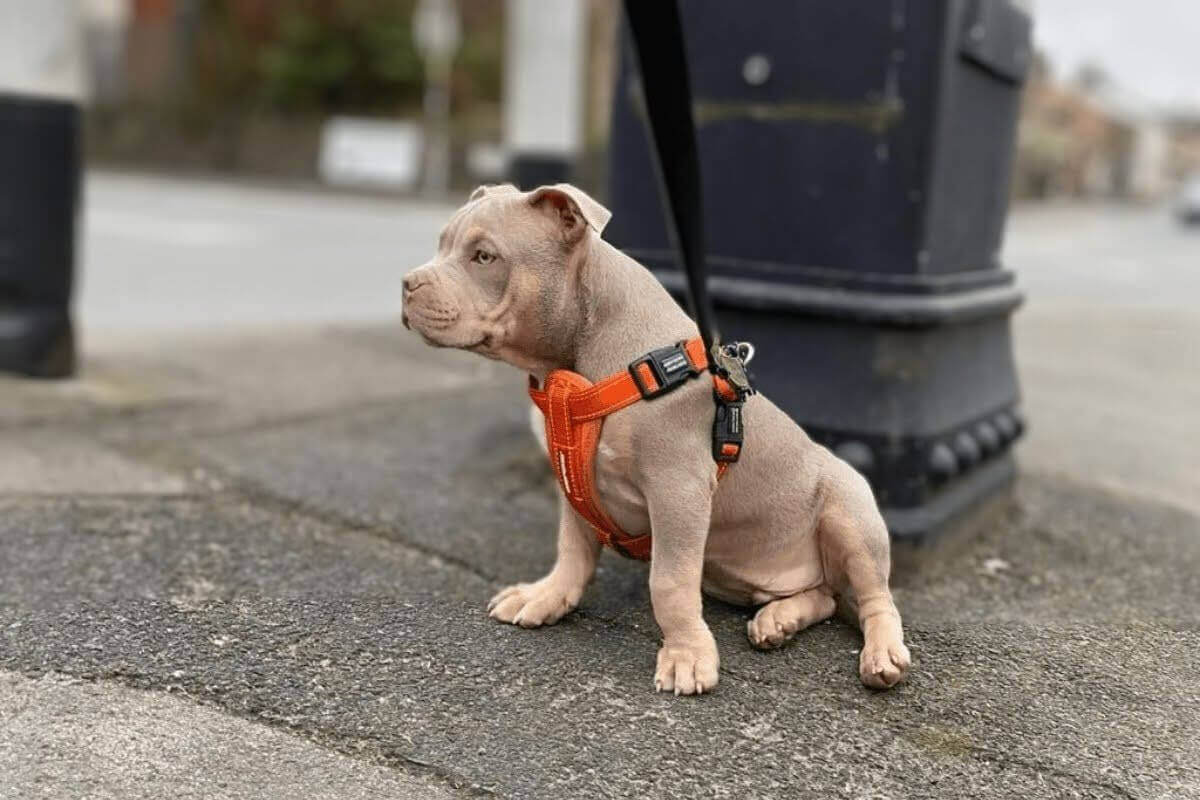The Pocket Bully is a miniature mixed breed that’s bred from the American Pit Bull Terrier and the Patterdale Terrier.
The resulting dog is a smaller version of an American Bully. Because this designer dog is a mixed breed, it was only recently recognized by kennel clubs around the world.
This mixed breed is sometimes called a Patterdale Pitbull or a Pocket Pitbull, although the use of these names is less common than Pocket Bully.
Despite their delayed recognition by kennel clubs, they’re still great pets. These companion dogs are highly sought after because of their size and personalities.
In the following guide, you’ll learn everything you need to know about this adorable mixed-breed dog, the Pocket Bully.

Pocket Bully Breed Overview
| Breed Name | Pocket Bully |
| Other Names | Miniature Pit Bull, Micro Pit Bull, and Pit Bull Patterdale Mix |
| Size | 12-16 inches |
| Weight | 11-24 pounds |
| Coat | Short and smooth |
| Color | Red, Fawn, Blue, Black, Blue and Tan, Black and Tan, Black Brindle, Buckskin, Brown, and Chocolate |
| Temperament | Friendly, Loyal, Intelligent, Active, Energetic |
| Activity Level | Moderate to high |
| Training | Easily trainable |
| Socialization | Good with children and other animals |
| Grooming | Low maintenance |
| Health Concerns | Prone to certain health issues such as breathing problems and hip dysplasia |
Pocket Bully Breed History
In the grand scheme of things, Pocket Bullies are a relatively new breed of dog.
In fact, their first recognition by the American Bully Kennel Club didn’t occur until 2004. The United Kennel Club recognized them nearly a decade later, in 2013.
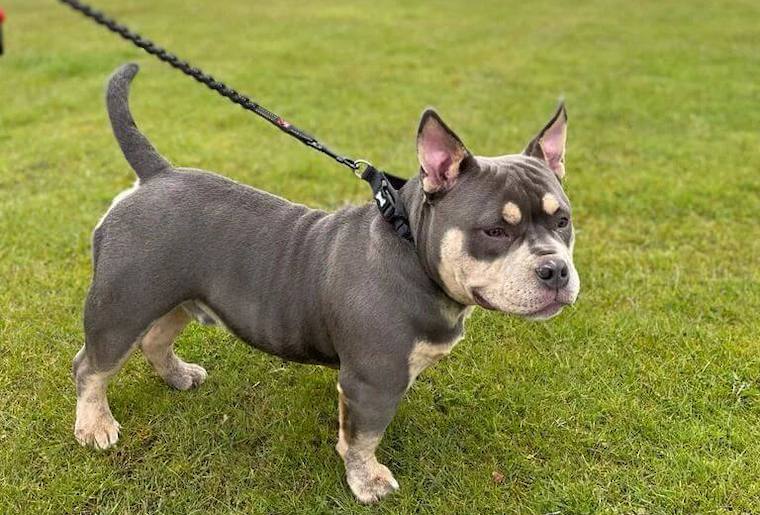
Breeders first created the Pocket Bully to create a fun-loving and loyal companion dog for less active dog owners.
Since these dogs don’t require a significant amount of exercise, they’re perfect for families of children or house-bound pet owners. Breeders only began intentionally breeding this hybrid a few decades ago.
These dogs combine the American Pit Bull’s bulky build with the shorter height of the Patterdale Terrier.
While the resulting puppies can take on the traits from either parent, this pairing typically creates a much smaller version of the American Pit Bull.
Pocket Bully Breed Appearance
The Pocket Bully is a small dog with a stocky, muscular body. They typically have wide heads, thick necks, and short legs.
While there can be some variation, they tend to have floppy ears and medium-length tails. Their coat is short, thick, and smooth.
Pocket Bully Size and Weight
Pocket Bullies are a miniature version of the American Bully breed.
They are created by breeding an American Pit Bull Terrier, a larger breed weighing 35-60 pounds and standing 18-21 inches tall, with a Patterdale Terrier, a smaller breed weighing 11-13 pounds and standing 9-15 inches tall.
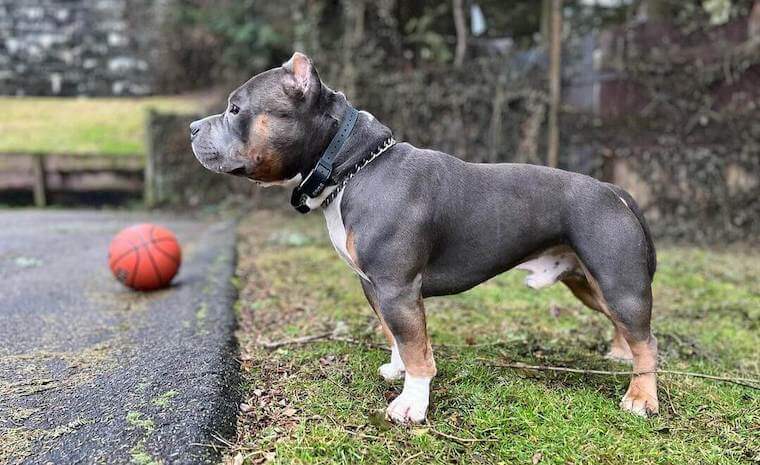
Although Pocket Bullies are smaller than American Pit Bull Terriers, they are still not small enough to fit in your pocket, but they are still considered a smaller breed compared to others.
Pocket Bullies typically grow to be up to 16-17 inches tall, with the females being slightly smaller than the males.
When fully grown, they usually weigh between 10 and 22 pounds. This is significantly smaller than the American Pit Bull Terrier, which can grow to be 60 pounds!
Pocket Bully Breed Traits
A Pocket Bully’s overall build resembles their American Bully parent. They are stocky and muscular.
Their thick necks connect their wide heads to their broad and shallow chests. Combined with their short and muscular legs, these features give them their distinctive look.
These dogs typically have floppy ears and thin, medium-length tails. Overall, they look very similar to American Pit Bull Terriers. However, they are only about a third of the size!
Pocket Bully Coat & Colors
American Pit Bull Terriers and Patterdale Terriers have slightly different coats. The American Bully’s coat is usually short and smooth without any undercoat.

On the other hand, Patterdales have a thin and coarse coat with a thick undercoat that protects them from cold weather.
Because of this, it is difficult to predict what the coat will be like on their offspring.
Although Pocket Bullies typically have short and smooth coats like American Pit Bulls, they may end up with a coat more like their Patterdale parent.
Pocket Bullies’ coats can be any number of colors. Common coat colors include blue, red, fawn, black, and buckskin.
In addition to solid coat colors, some may have markings in a second color. Color combinations include black and tan, blue and tan, or white and seal.
Pocket Bully Grooming Needs
It’s relatively easy to keep a Pocket Bully groomed, especially if her coat is like her American Pit Bull parent’s coat.
Even if she has the trickier coat of her Patterdale parent, it will be short and relatively easy to maintain.
You should bathe your Pocket Bully at least once each week. While these dogs do not require daily brushing, you should brush out their fur two to four times per week.
Pocket Bullies don’t shed a lot, so they are usually easy to keep well-groomed and clean.
Pocket Bully Lifespan
The typical lifespan of a Pocket Bully is between 10 and 13 years. This mixed breed is typically healthy, contributing to its longer lifespan.
With proper diet, exercise, and veterinary care, these dogs can spend well over a decade with you and your family.

Pocket Bully Health Issues
Although Pocket Bullies are a relatively healthy breed, they do have a few known health issues. The following are four issues relatively common in Pocket Bullies (and other Bully breeds).
Hip Dysplasia
This condition occurs when the cartilage in the hip joint wears down.
This causes the thigh bone and hip socket to rub against each other, which wears down and deforms the bone. Severe cases of hip dysplasia can cause pain and loss of function in the hip.
Pocket Bullies are prone to this condition because their bones often develop faster than the muscle needed to hold them in their proper place. This can accelerate the deterioration of the hip joint cartilage.
Skin Problems
Several skin diseases plague Pocket Bullies. Eczema and seborrhea are two of the most common. When a dog has eczema, he develops itchy, dry patches of either red or flaky skin.
Seborrhea, on the other hand, can either cause dry skin or oily skin (since the condition causes the oil glands on the skin to either under- or over-produce these oils).
Their skin is also exceptionally sensitive, leaving them susceptible to irritation from over-grooming, allergies, or parasites.
To treat the skin irritation, Pocket Bully owners will have to find out exactly what’s causing the issue.
Eye Issues
Pocket Bullies, just like Frenchies, are prone to several different eye issues, such as “Cherry eye.”
It’s a condition that causes the gland on the third eyelid to move out of place, is one such condition. When Pocket Bullies develop cherry eye, it is usually treated surgically.
Pocket Bullies are also prone to entropion, corneal ulcers, and dry eye. All these conditions require veterinary intervention. In many cases, surgery may be necessary.
Congenital Heart Disease
Pocket Bullies are particularly vulnerable to different congenital heart diseases such as septal defect, mitral valve disease, and subaortic and pulmonic stenosis.
Although these conditions are genetic, obesity and other triggers may make them worse.

Pocket Bully Diet
When your Pocket Bully is a puppy, he should have a diet with at least 30% protein and 20% fat. This diet will support healthy growth and development.
As your dog reaches adulthood, feed him high-quality dog kibble twice daily. While you should still consult your dog’s veterinarian about specific dietary needs, the amount you feed your dog will typically depend on how much he weighs.
Like all dogs, this breed loves treats. However, you need to refrain from overfeeding treats, as these can cause unhealthy weight gain.
Pocket Bully Exercise Requirements
Pocket Bullies were bred to require relatively little exercise. In general, they have moderate energy levels and only need about one walk each day.
Since they are playful dogs, scheduling playtime will be an important part of their daily care.
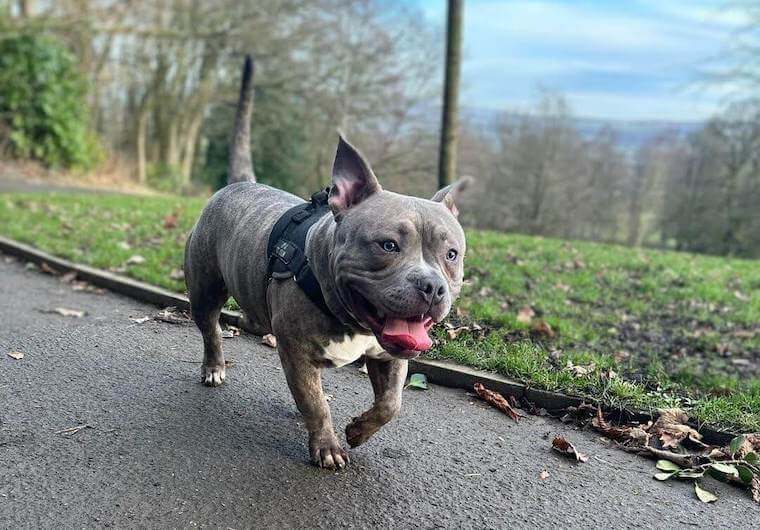
Because of their size, you can play with them either in your home or outdoors. Not only will this help you build a better bond with your dog, but it will keep them happy and healthy.
During poor weather conditions, extended playtime indoors will sufficiently meet a Pocket Bully’s needs.
Mental stimulation (such as treat puzzles or snuffle mats) can also help your dog burn off excess energy when going outside to play isn’t an option.
Pocket Bully Temperament
Pocket Bullies are friendly and loving. While they may take on temperament traits from either parent, they tend to be a very loyal and playful mixed breed. These dogs are often bright and energetic, making them great family pets.
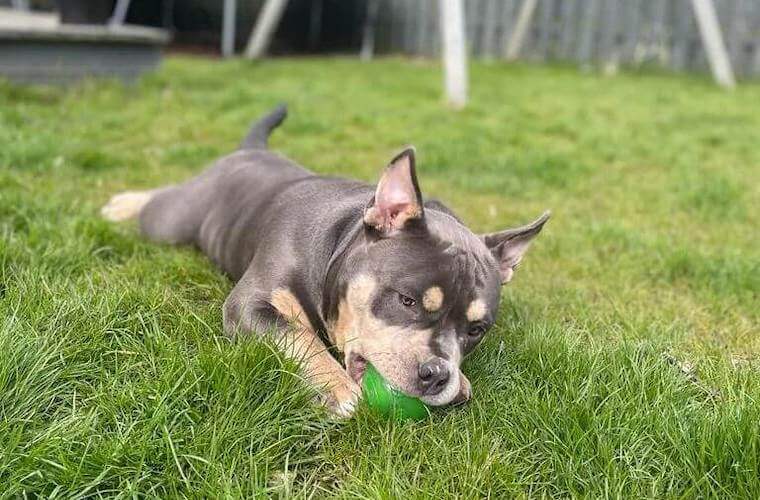
Their high intellect makes them relatively easy to train. They respond particularly well to positive reinforcement (like treats or verbal praise).
Training these dogs is especially important, since untrained and under-socialized Pocket Bullies may have issues around strangers or other dogs.
These dogs tend to be especially protective of their owners. If they feel like their owners are in danger, they can show extreme courage in defending the people they love.
Although they’re courageous, their small size makes them unsuitable guard dogs. They’re best suited as loving companion dogs.
Pocket Bully Cost
The Pocket Bully is a designer breed, which means it comes with a designer price tag.
These small dogs often cost around $1000, since the demand for them often outpaces the supply. The price of these dogs has only grown over the last several years.
In some areas, you may be able to get one for as little as $500. However, there are some breeders who charge $5000 or more for these highly sought-after pups.
You might be able to save some money on a Pocket Bully by adopting an adult dog from a shelter. Adoption fees for dogs tend to be significantly less than the price of a puppy.
In many cases, you’ll also have a better idea of your dog’s medical needs and temperament before bringing him into your home.

FAQs on Pocket Bullies
A Pocket Bully is a small to medium-sized dog breed that is a miniature version of the American Bully.
Pocket Bullies typically weigh between 11-24 pounds and stand at around 12-16 inches tall.
Yes, Pocket Bullies are known to be friendly and affectionate with children. However, as with any dog, if not socialized properly and mistreated, they may become aggressive.
Pocket Bullies share many of the same health concerns as the American Bully, such as Hip Dysplasia, Heart Disease, Skin Infections, and Hypothyroidism. Additionally, they may be more prone to skeletal issues due to their compact build.
The cost of a Pocket Bully can vary depending on the breeder and location, but on average, they can cost between $1,000 to $4,000.
Featured image credit: @Rolo_The_PocketBully
